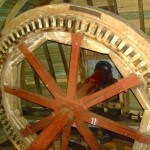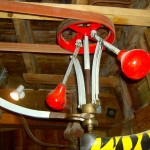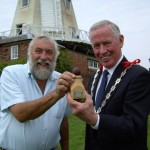The windmill, a white smock mill built in 1869 onto a two storey red brick base with attached miller’s cottage, is now a Grade II* listed building. It incorporates “patent” type shutters in the Sweeps instead of canvas and Sails, and produced enough power to turn four sets of mill stones as well as the maize and oats crushing/cutting machines. This mill replaced a smaller smock mill (age unknown) which had been in operation previously on the same site and whose sweeps were reported coming very close to the ground. Information received recently states that the current windshaft and brake wheel were reclaimed from that old mill – a common practice amongst millwrights – this could mean that other items were also re-used.
Three years later in 1872 a steam engine was added to allow the mill to keep working when the wind had dropped. At the turn of the 20th century, the very tall square chimney stack made the mill a very prominent feature on the local landscape . However, due to economic reasons (mainly labour costs) the steam engine and chimney were removed in 1911, although the boiler and boiler house still remain to this day. In 1912 a more reliable Campbell gas-oil engine was installed and this continued to provide auxiliary power until replaced by an 25hp electric motor in 1938 when electricity came to Willesborough.
Not enough of the old Campbell engine remained to effect a restoration, so a working 1906 Hornsby 14hp gas-oil (similar type) engine has now been installed in its place, and has been linked to the auxiliary drive. The Sails, or Sweeps as they are known in this part of Kent, finally stopped turning in the late 1930’s (cheaper electric power) when the mill could no longer compete with the local roller flour mills. Using only the electric auxiliary power the mill changed over to producing animal feed, grinding peas and beans, and crushing oats and maize. Some flour was produced using a smaller set of stones driven off a lay shaft.
This operation continued through the War years until the 1950’s when further Industrial mechanization in commercial milling caused its closure, the mill building then being used for storage only and later as a home until 1989. It was bought, in a very dilapidated state, and fully restored in 1991 to its former glory by Ashford Borough Council for the benefit of the citizens of Ashford and the public at large.



